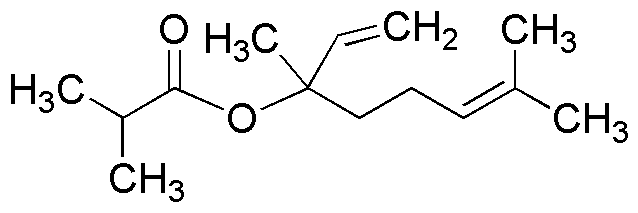Linalyl isobutyrate is widely utilized in research focused on:
- Fragrance Industry: This compound is a key ingredient in perfumes and cosmetics, providing a pleasant floral scent that enhances product appeal.
- Flavoring Agents: It is used in food and beverage formulations to impart fruity and floral flavors, making it popular in the culinary industry.
- Aromatherapy: Linalyl isobutyrate is valued for its calming properties, often included in essential oil blends for stress relief and relaxation.
- Pharmaceuticals: This compound is explored for its potential therapeutic effects, including anti-inflammatory and antimicrobial properties, contributing to innovative drug formulations.
- Household Products: It is commonly found in cleaning products and air fresheners, where it helps mask unpleasant odors and provides a fresh scent.
General Information
Properties
Safety and Regulations
Applications
Linalyl isobutyrate is widely utilized in research focused on:
- Fragrance Industry: This compound is a key ingredient in perfumes and cosmetics, providing a pleasant floral scent that enhances product appeal.
- Flavoring Agents: It is used in food and beverage formulations to impart fruity and floral flavors, making it popular in the culinary industry.
- Aromatherapy: Linalyl isobutyrate is valued for its calming properties, often included in essential oil blends for stress relief and relaxation.
- Pharmaceuticals: This compound is explored for its potential therapeutic effects, including anti-inflammatory and antimicrobial properties, contributing to innovative drug formulations.
- Household Products: It is commonly found in cleaning products and air fresheners, where it helps mask unpleasant odors and provides a fresh scent.
Documents
Safety Data Sheets (SDS)
The SDS provides comprehensive safety information on handling, storage, and disposal of the product.
Product Specification (PS)
The PS provides a comprehensive breakdown of the product’s properties, including chemical composition, physical state, purity, and storage requirements. It also details acceptable quality ranges and the product's intended applications.
Certificates of Analysis (COA)
Search for Certificates of Analysis (COA) by entering the products Lot Number. Lot and Batch Numbers can be found on a product’s label following the words ‘Lot’ or ‘Batch’.
*Catalog Number
*Lot Number
Certificates Of Origin (COO)
This COO confirms the country where the product was manufactured, and also details the materials and components used in it and whether it is derived from natural, synthetic, or other specific sources. This certificate may be required for customs, trade, and regulatory compliance.
*Catalog Number
*Lot Number
Safety Data Sheets (SDS)
The SDS provides comprehensive safety information on handling, storage, and disposal of the product.
DownloadProduct Specification (PS)
The PS provides a comprehensive breakdown of the product’s properties, including chemical composition, physical state, purity, and storage requirements. It also details acceptable quality ranges and the product's intended applications.
DownloadCertificates of Analysis (COA)
Search for Certificates of Analysis (COA) by entering the products Lot Number. Lot and Batch Numbers can be found on a product’s label following the words ‘Lot’ or ‘Batch’.
*Catalog Number
*Lot Number
Certificates Of Origin (COO)
This COO confirms the country where the product was manufactured, and also details the materials and components used in it and whether it is derived from natural, synthetic, or other specific sources. This certificate may be required for customs, trade, and regulatory compliance.

